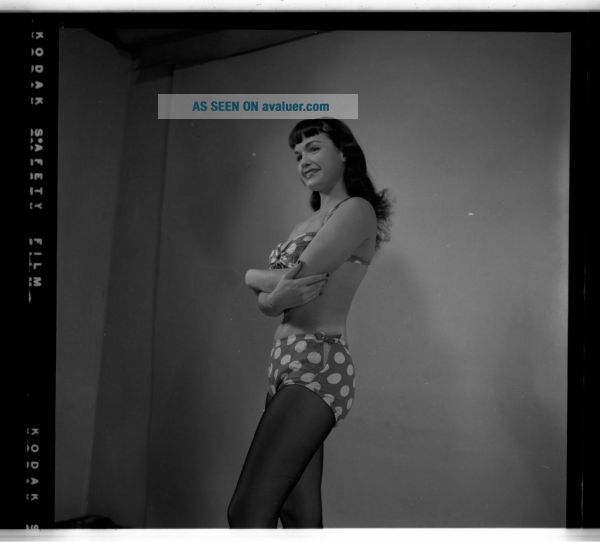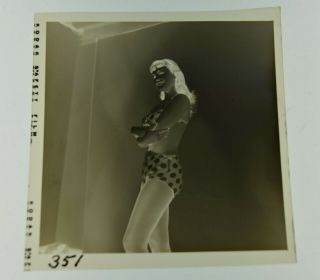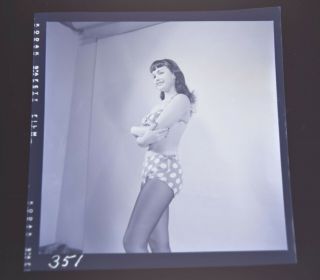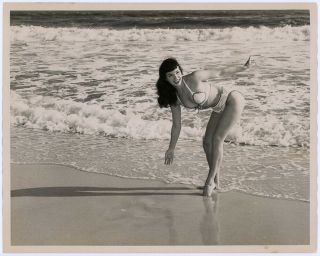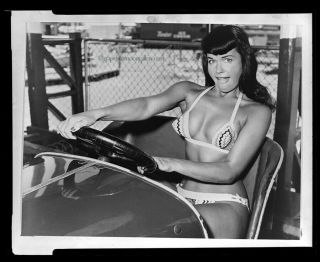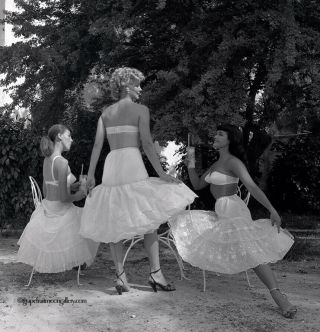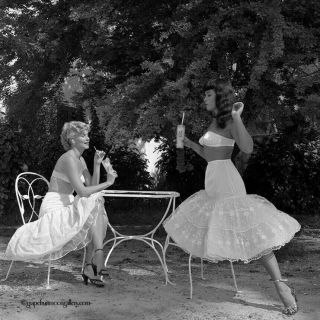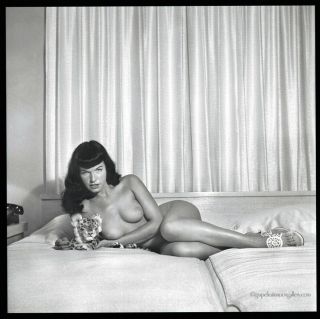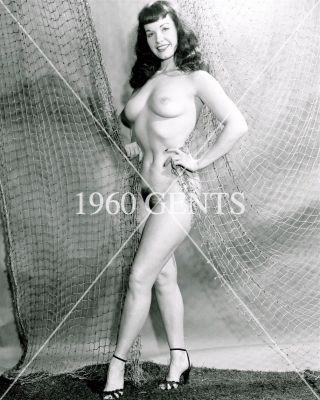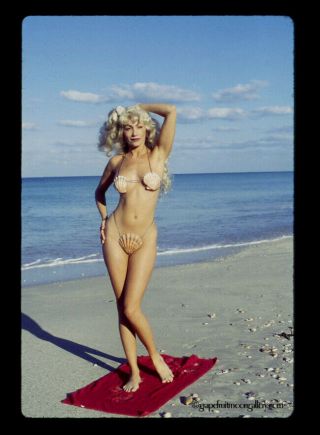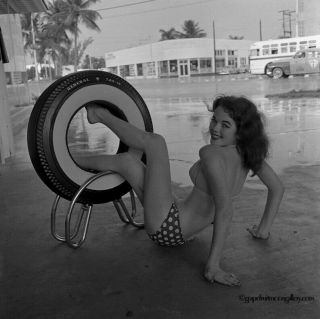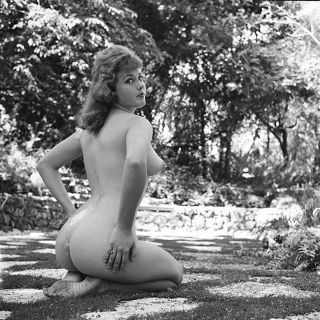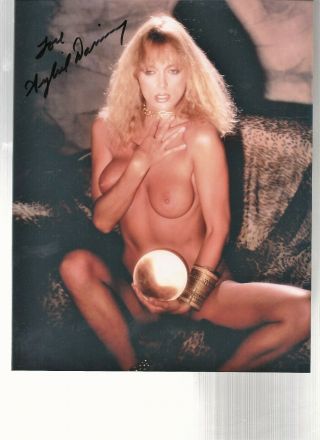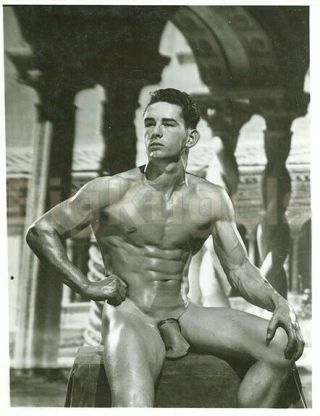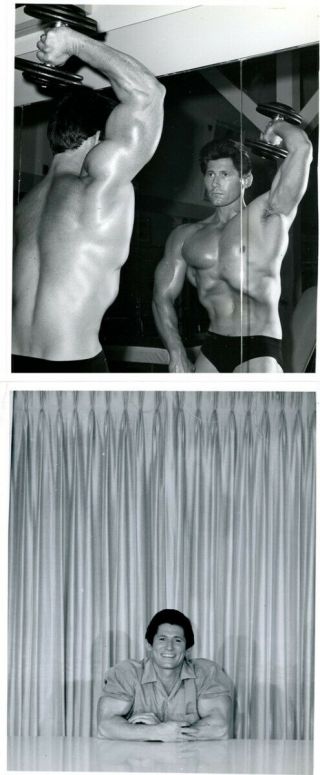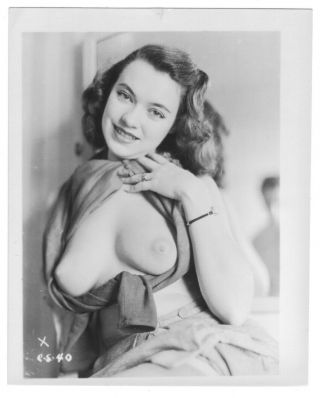BETTIE PAGE CAMERA NEGATIVE VINTAGE 1954 PHOTOGRAPH PIN - UP Robert Stanton
Item History & Price
Bettie Page, the brunet pinup queen with a shoulder-length pageboy hairdo and kitschy bangs whose saucy photos helped usher in the sexual revolution of the 1960s, has died. She was 85.
Page, whose later life was marked by depression, violent mood swings and several years... in a state mental institution, died Thursday night at Kindred Hospital in Los Angeles, where she had been on life support since suffering a heart attack Dec. 2, according to her agent, Mark Roesler.
A cult figure, Page was most famous for the estimated 20, 000 4-by-5-inch black-and-white glossy photographs taken by amateur shutterbugs from 1949 to 1957. The photos showed her in high heels and bikinis or negligees, bondage apparel -- or nothing at all.
Decades later, those images inspired biographies, comic books, fan clubs, websites, commercial products -- Bettie Page playing cards, dress-up magnet sets, action figures, Zippo lighters, shot glasses -- and, in 2005, a film about her life and times, "The Notorious Bettie Page."
Then there are the idealized portraits of her naughty personas -- Nurse Bettie, Jungle Bettie, Voodoo Bettie, Banned in Boston Bettie, Maid Bettie, Crackers in Bed Bettie -- memorialized by such artists as Olivia de Berardinis.
"I'll always paint Bettie Page, " De Berardinis said Thursday night . "But truth be told, it took me years to understand what I was looking at in the old photographs of her. Now I get it. There was a passion play unfolding in her mind. What some see as a bad-girl image was in fact a certain sensual freedom and play-acting - it was part of the fun of being a woman."
"The origins of what captures the imagination and creates a particular celebrity are sometimes difficult to define, " Playboy magazine founder Hugh Hefner said Thursday night. "Bettie Page was one of Playboy magazine's early Playmates, and she became an iconic figure, influencing notions of beauty and fashion. Then she disappeared. . . . Many years later, Bettie resurfaced and we became friends. Her passing is very sad."
In an interview 2 1/2 years ago, Hefner described Page's appeal as "a combination of wholesome innocence and fetish-oriented poses that is at once retro and very modern."
According to her agents at CMG Worldwide, Page's official website, www.BettiePage.com, has received about 600 million hits over the last five years.
"Bettie Page captured the imagination of a generation of men and women with her free spirit and unabashed sensuality, " said Roesler, chairman of the Indianapolis-based CMG Worldwide, who was at Page's side when she died. "She was a dear friend and a special client and one of the most beautiful and influential women of the 20th century."
A religious woman in her later life, Page was mystified by her influence on modern popular culture. "I have no idea why I'm the only model who has had so much fame so long after quitting work, " she said in an interview with The Times in 2006.
She had one request for that interview: that her face not be photographed.
"I want to be remembered, " she said, "as I was when I was young and in my golden times. . . . I want to be remembered as the woman who changed people's perspectives concerning nudity in its natural form."
Bettie Mae Page was born April 22, 1923, in Nashville. She was the oldest girl among Roy and Edna Page's six children. Her father, an auto mechanic, "molested all three of his daughters, " Page said in the interview.
Her parents divorced in 1933, but life didn't get any easier for Bettie.
"All I ever wanted was a mother who paid attention to me, " Page recalled. "She didn't want girls. She thought we were trouble. When I started menstruating at 13, I thought I was dying because she never taught me anything about that."
After high school, Page earned a teaching credential. But her career in the classroom was short-lived. "I couldn't control my students, especially the boys, " she said.
She tried secretarial work and marriage. But by 1948 she had divorced a violent husband and fled to New York City, where she enrolled in acting classes. She was noticed on the beach at Coney Island by New York police officer and amateur photographer Jerry Tibbs, who introduced her to camera clubs.
Page quickly became a sought-after model, attracting the attention of Irving Klaw and his sister, Paula, who operated a mail-order business specializing in cheesecake and bondage poses.
Under contract with the Klaws, Page was photographed prancing around with a whip, spanking other women, even being hog-tied. She also appeared in 8-millimeter "loops" and feature-length peekaboo films with titles like "Betty Page in High Heels."
"I had lost my ambition and desire to succeed and better myself; I was adrift, " Page recalled. "But I could make more money in a few hours modeling than I could earn in a week as a secretary."
Her most professional photographs were taken in 1955 by fashion photographer Bunny Yeager. They included shots of Page nude and frolicking in waves and deep-sea fishing, and a January 1955 Playboy centerfold of her winking under a Santa Claus cap.
At 35, Page walked away from it all. She quit modeling and moved to Florida, where she married a much younger man whose passions, she later learned, were watching television and eating hamburgers.
Page fled from her home in tears after a dispute on New Year's Eve in 1959. Down the street, she noticed a white neon sign over a little white church with its door open.
After quietly taking a seat in the back, she had a born-again experience. Page immersed herself in Bible studies and served as a counselor for the Billy Graham Crusade.
In 1967, she married for a third time. After that marriage ended in divorce 11 years later, Page plunged into a depression marked by violent mood swings. She argued with her landlady and attacked her with a knife. A judge found her innocent by reason of insanity but sentenced her to 10 years in a California mental institution.
She was released in 1992 from Patton State Hospital in San Bernardino County to find that she had unwittingly become a pop-culture icon. A movie titled "The Rocketeer" and the comic book that inspired it contained a Bettie-esque character, triggering a revival, among women as well as men, that continues unabated.
With the help of admirers including Hefner, Page finally began receiving a respectable income for her work.
In an interview published in Playboy magazine in 2007, Page expressed mixed feelings about her achievements. "When I turned my life over to the lord Jesus I was ashamed of having posed in the nude, " she said. "But now, most of the money I've got is because I posed in the nude. So I'm not ashamed of it now. But I still don't understand it."
She spent most of her final years in a one-bedroom apartment, reading the Bible, listening to Christian and country tunes, watching westerns on television, catching up on diet and exercise regimens or sometimes perusing secondhand clothing stores.
Occasionally, however, Page was persuaded to visit the Sunset Boulevard penthouse offices of her agents at CMG Worldwide to autograph pinups of herself in the post-World War II years of her prime. The agency controls her image and those of Marilyn Monroe and Princess Diana, among others.
During one such event in early 2006, Page needed about 10 minutes to get through the 10 letters of her name. As she pushed her pen over a portrait of her in a negligee with an ecstatic smile, she laughed and said, "My land! Is that supposed to be me? I was never that pretty."
She is survived by her brother Jack Page of Nashville and sister Joyce Wallace of Blairsville, Ga.
Bettie Mae Page (April 22, 1923 – December 11, 2008) was an American model who gained a significant profile in the 1950s for her pin-up photos.[2][3] Often referred to as the "Queen of Pinups", her jet-black hair, blue eyes, and trademark fringe have influenced artists for generations.[4]
A native of Nashville, Tennessee, Page lived in California in her early adult years before moving to New York City to pursue work as an actress. There, she began to find work as a pin-up model, and posed for dozens of photographers throughout the 1950s. Page was "Miss January 1955", one of the earliest Playmates of the Month for Playboy magazine. "I think that she was a remarkable lady, an iconic figure in pop culture who influenced sexuality, taste in fashion, someone who had a tremendous impact on our society, " said Playboy founder Hugh Hefner to the Associated Press in 2008.[5]
In 1959, Page converted to evangelical Christianity and worked for Billy Graham, [6] studying at Bible colleges in Los Angeles and Portland, Oregon, with the intent of becoming a missionary. The latter part of Page's life was marked by depression, violent mood swings, and several years in a state psychiatric hospital suffering from paranoid schizophrenia.[7][8][9] After years of obscurity, she experienced a resurgence of popularity in the 1980s.
Contents1 Early life2 Modeling career2.1 Discovery and early work2.2 1952–57: Irving Klaw; film work2.3 1958–92: Retirement; departure from spotlight3 Revival of public interest4 Death5 Biographies6 In popular culture6.1 Fashion and visual art6.2 In fiction and literature6.3 Music6.4 Astronomy7 Filmography8 See also9 References10 External linksEarly lifePage was born in Nashville, Tennessee, the second of six children to Walter Roy Page (1896–1964)[10] and Edna Mae Pirtle (1901–1986).[11][12][13] At a young age, Page had to face the responsibilities of caring for her younger siblings. Her parents divorced when she was 10 years old. In the 1930 Census, a few weeks before Bettie's 7th birthday, her mother Edna Pirtle Page was already listed as being divorced. After her father, whom Page would accuse of molesting her starting at age 13, was imprisoned, [14] Page and her two sisters lived in a Protestant orphanage for a year.[7] During this time, Page's mother worked two jobs, one as a hairdresser during the day and washing laundry at night.
As a teenager, Page and her sisters tried different makeup styles and hairdos imitating their favorite movie stars. She also learned to sew. These skills proved useful years later for her pin-up photography when Page did her own makeup and hair and made her own bikinis and costumes. During her early years, the Page family traveled around the country in search of economic stability.[13]
A good student and debate team member at Hume-Fogg High School, she was voted "Most Likely to Succeed".[13] On June 6, 1940, Page graduated as the salutatorian of her high school class[13] with a scholarship. She enrolled at George Peabody College (now part of Vanderbilt University), with the intention of becoming a teacher. However, the next fall she began studying acting, hoping to become a movie star. At the same time, she got her first job, typing for author Alfred Leland Crabb. Page graduated from Peabody with a Bachelor of Arts degree in 1944.
In 1943, she married high school classmate Billy Neal in a simple courthouse ceremony shortly before he was drafted into the Army for World War II.[15][16] For the next few years, she moved from San Francisco to Nashville to Miami and to Port-au-Prince, Haiti, where she felt a special affinity with the country, its people and its culture.[13] In November 1947, back in the United States, she filed for divorce.[citation needed]
File:Bettiepage-teaserama-1955-selection.webmBettie Page as seen in the 1955 movie TeaseramaModeling careerDiscovery and early workIn 1949, [17] Page moved to New York City, where she hoped to find work as an actress. In the meantime, she supported herself by working as a secretary overlooking Rockefeller Center.[7] In 1950, while walking alone along the Coney Island shore, Bettie met NYPD Officer Jerry Tibbs, who was an avid photographer, and he gave Bettie his card. He suggested she'd make a good pin-up model, and in exchange for allowing him to photograph her, he'd help make up her first pin-up portfolio, free of charge.[13] It was Officer Tibbs who suggested to Bettie that she style her hair with bangs in front, to keep light from reflecting off her high forehead when being photographed.[7] Bangs soon became an integral part of her distinctive look.
In late-1940s America, "camera clubs" were formed to circumvent laws restricting the production of nude photos. These camera clubs existed ostensibly to promote artistic photography, but in reality, many were merely fronts for the making of pornography. Page entered the field of "glamour photography" as a popular camera club model, working initially with photographer Cass Carr.[13] Her lack of inhibition in posing made her a hit, and her name and image became quickly known in the erotic photography industry. In 1951, Bettie's image appeared in men's magazines such as Wink, Titter, Eyefull and Beauty Parade.[13]
1952–57: Irving Klaw; film work
Page appearing in S&M and bondage reels by Irving and Paula KlawFile:Bettie Page Klaw film.ogvA video featuring Bettie Page as a slave, lashing out against her Mistress and then getting spanked, 1955From 1952 through 1957, she posed for photographer Irving Klaw for mail-order photographs with pin-up and BDSM themes, making her the first famous bondage model. Klaw also used Page in dozens of short, black-and-white 8mm and 16mm "specialty" films, which catered to specific requests from his clientele. These silent 'one-reel' featurettes showed women clad in lingerie and high heels, acting out fetishistic scenarios of abduction, domination, and slave-training; bondage, spanking, and elaborate leather costumes and restraints were included periodically. Page alternated between playing a stern dominatrix, and a helpless victim bound hand and foot.
Klaw also produced a line of still photos taken during these sessions. Some have become iconic images, such as his highest-selling photo of Page—shown gagged and bound in a web of ropes, from the film Leopard Bikini Bound. Although these "underground" features had the same crude style and clandestine distribution as the pornographic "stag" films of the time, Klaw's all-female films (and still photos) never featured any nudity or explicit sexual content. Commenting on the bondage photos and the reputation they afforded her, Page said retrospectively:
They keep referring to me in the magazines and newspapers and everywhere else as the "Queen of Bondage." The only bondage posing I ever did was for Irving Klaw and his sister Paula. Usually every other Saturday he had a session for four or five hours with four or five models and a couple of extra photographers, and in order to get paid you had to do an hour of bondage. And that was the only reason I did it. I never had any inkling along that line. I don’t really disapprove of it; I think you can do your own thing as long as you’re not hurting anybody else — that’s been my philosophy ever since I was a little girl. I never looked down my nose at it. In fact, we used to laugh at some of the requests that came through the mail, even from judges and lawyers and doctors and people in high positions. Even back in the ’50s they went in for the whips and the ties and everything else.[18]
In 1953, Page took acting classes at the Herbert Berghof Studio, which led to several roles on stage and television. She appeared on The United States Steel Hour and The Jackie Gleason Show.[13] Her Off-Broadway productions included Time is a Thief and Sunday Costs Five Pesos. Page acted and danced in the feature-length burlesque revue film Striporama by Jerald Intrator in which she was given a brief speaking role. She then appeared in two more burlesque films by Irving Klaw (Teaserama and Varietease). These featured exotic dance routines and vignettes by Page and well-known striptease artists Lili St. Cyr and Tempest Storm. All three films were mildly risque, but none showed any nudity or overtly sexual content.
In 1954, during one of her annual vacations to Miami, Florida, Page met photographers Jan Caldwell, H. W. Hannau and Bunny Yeager.[13] At that time, Page was the top pin-up model in New York. Yeager, a former model and aspiring photographer, signed Page for a photo session at the now-closed wildlife park Africa USA in Boca Raton, Florida. The Jungle Bettie photographs from this shoot are among her most celebrated. They include nude shots with a pair of cheetahs named Mojah and Mbili. The leopard skin patterned Jungle Girl outfit she wore was made, along with much of her lingerie, by Page herself. A large collection of the Yeager photos, and Klaw's, were published in the book Bettie Page Confidential (St. Martin's Press, 1994).
After Yeager sent shots of Page to Playboy founder Hugh Hefner, he selected one to use as the Playmate of the Month centerfold in the January 1955 issue of the two-year-old magazine. The famous photo shows Page, wearing only a Santa hat, kneeling before a Christmas tree holding an ornament and playfully winking at the camera. In 1955, Page won the title "Miss Pinup Girl of the World".[13] She also became known as "The Queen of Curves" and "The Dark Angel". While pin-up and glamour models frequently have careers measured in months, Page was in demand for several years, continuing to model until 1957.[4]
Although she frequently posed nude, she never appeared in scenes with explicit sexual content. In 1957, Page gave "expert guidance" to the FBI regarding the production of "flagellation and bondage pictures" in Harlem.[19]
1958–92: Retirement; departure from spotlightThe reasons reported for Page's departure from modeling vary. Some reports mention the Kefauver Hearings of the United States Senate Special Committee to Investigate Crime in Interstate Commerce (after a young man apparently died during a session of bondage which was rumored to be inspired by bondage images featuring Page). However, the most likely reason for Page ending her modeling career and severing all contact with her prior life was her conversion to born-again Christianity while living in Key West, Florida, in 1959.[20]
Photographer Sam Menning was the last person to photograph a pin-up of Page before her retirement.[21]
On New Year's Eve 1958, during one of her regular visits to Key West, Florida, Page attended a service at what is now the Key West Temple Baptist Church. She found herself drawn to the multiracial environment and started to attend on a regular basis. She would, in time, attend three bible colleges, including the Bible Institute of Los Angeles, Multnomah University in Portland, Oregon and, briefly, a Christian retreat known as "Bibletown", part of the Boca Raton Community Church, Boca Raton, Florida.
She dated industrial designer Richard Arbib in the 1950s, and then married Armond Walterson in 1958;[22] they divorced in 1963.[7]
During the 1960s, she attempted to become a Christian missionary in Africa, but was rejected for having had a divorce. Over the next few years, she worked for various Christian organizations before settling in Nashville in 1963, and re-enrolled at Peabody College to pursue a master's degree in education, but eventually dropped out.[7] She worked full-time for Rev. Billy Graham.[4][6]
She briefly remarried Billy Neal, her first husband, who helped her to gain entry into missionary work; however, the two divorced again shortly thereafter.[citation needed] She returned to Florida in 1967, and married again, to Harry Lear, [23] but this marriage ended in divorce in 1972.[citation needed]
She moved to Southern California in 1979.[6] There she had a nervous breakdown and had an altercation with her landlady. The doctors who examined her diagnosed her with acute schizophrenia, and she spent 20 months in Patton State Hospital in San Bernardino, California. After a fight with another landlord, she was arrested for assault, but was found not guilty by reason of insanity and placed under state supervision for eight years.[6] She was released in 1992.[9]
Revival of public interestIn the 1970s, artists Eric Stanton, Robert Blue and Olivia De Berardinis were among the first to start painting Bettie images. In 1979, artist Robert Blue had a show titled Steps Into Space, at a gallery on Melrose Place in Los Angeles, where he showed his collection of Bettie Page paintings. At that time in New York, De Berardinis had begun painting Bettie for Italian jean manufacturer Fiorucci. De Berardinis has continued to paint Bettie, and compiled a collection of this artwork in a book titled Bettie Page by Olivia (2006), with a foreword by Hugh Hefner.[13][24]
In 1976, Eros Publishing Co. published A Nostalgic Look at Bettie Page, a mixture of photos from the 1950s. Between 1978 and 1980, Belier Press published four volumes of Betty Page: Private Peeks, reprinting pictures from the private-camera-club sessions, which reintroduced Page to a new but small cult following.[25] In 1983, London Enterprises released In Praise of Bettie Page — A Nostalgic Collector's Item, reprinting camera-club photos and an old cat fight photo shoot.[citation needed]
A larger cult following was built around Page during the 1980s, of which she was unaware. This renewed attention was focused on her pinup and lingerie modeling rather than those depicting sexual fetishes or bondage. This attention also prompted speculation of what happened to her after the 1950s. The 1990s edition of Book of Lists[26] included Page in a list of once-famous celebrities who had vanished from the public eye.
In the early 1980s, comic-book artist Dave Stevens based the female love interest of his hero Cliff Secord (alias "The Rocketeer") on Page.[27]
By the mid-1980s, De Berardinis noted that women began to frequent her gallery openings sporting Bettie bangs, fetish clothing, and tattoos of Page. She described “black bangs, seamed stockings and snub-nosed 6-inch stilettos. These are Bettie Page signatures.... Although the fantasy world of fetish/bondage existed in some form since the beginning time, Bettie is the iconic figurehead of it all. No star of this genre existed before her. Monroe had predecessors, Bettie did not.” [13]
In 1987, Greg Theakston started a fanzine called The Betty Pages[25] and recounted tales of her life, particularly the camera-club days. Additionally, numerous articles about the missing pop-cultural figure began appearing in the mainstream media. Since almost all of her photos were in the public domain, [citation needed] some entities launched Page-related products.
In a 1993 telephone interview with Lifestyles of the Rich and Famous, Page told host Robin Leach that she had been unaware of the resurgence of her popularity, stating that she was "penniless and infamous". Entertainment Tonight produced a segment on her. Page was living in a group home in Los Angeles. Theakston contacted her and extensively interviewed her for The Betty Page Annuals V.2.[citation needed]
My son had noticed all the books and calendars and plates being sold with her face on them, ...I called her up and said, `Bettie, there is a chance for you to make money off this"her brother, Jack[28]
In 1993, [29] Jack persuaded Page to pursue royalties through Chicago attorney James L. Swanson.[28] James L. Swanson and Karen Essex wrote a coffee table book, Bettie Page: The Life of a Pin-Up Legend[30][31]
“ ...it was her appearance on Lifestyles of the Rich and Famous, an American TV show that ran from 1984 to 1995, that led to her acquiring an agent, Everett Fields, the grandson of WC (Fields). One of his partners, Swanson, took over her management and co-authored her biography, but the relationship deteriorated into lawsuits. It was primarily Stevens and JB Rund, the publisher of Private Peeks, who worked to get her better representation, which helped her collect royalties on the images of her used in popular culture.[32] ”Three years later, nearly penniless and failing to receive any royalties, Page fired Swanson.[citation needed]
In 1993, Page signed[33] with Mark Roesler[34][35] and his Curtis Management Group, Incorporated, [36] later CMG Worldwide.[35][37] CMG Worldwide has also represented the James Dean and Marilyn Monroe estates.[38][39][40] Page occasionally autographed pinups at her agents' CMG Worldwide penthouse offices on Sunset Boulevard[41] Page began collecting payments via CMG Worldwide.[citation needed]
After Jim Silke made a large-format comic featuring Page's likeness, Dark Horse Comics on the 1990s published a comic book based on her fictional adventures.[citation needed] Eros Comics published several Bettie Page titles, including the tongue-in-cheek Tor Love Bettie which comically suggested a romance between Page and wrestler-turned-Ed Wood film actor, Tor Johnson.[citation needed]
The question of what Page did in the obscure years after modeling was answered in part with the publication of an official biography in 1996, Bettie Page: The Life of a Pin-up Legend.[42] That year, Page granted a TV interview to entertainment reporter Tim Estiloz for the NBC morning magazine program Real Life. At Page's request, her face was not shown. The interview was broadcast only once.[citation needed]
Another biography, The Real Bettie Page: The Truth about the Queen of Pinups (1997)[43] was written by Richard Foster. The book stated that a Los Angeles County Sheriff's police report said Page suffered from paranoid schizophrenia and, at age 56, had stabbed her elderly landlords[32] on the afternoon of April 19, 1979 in an unprovoked attack, during a fit of insanity.[44]
In 1997, E! True Hollywood Story aired a feature on Page titled, Bettie Page: From Pinup to Sex Queen.[45]
In a late-1990s interview, Page stated she would not allow any current pictures of her to be shown because of concerns about her weight. However, in 1997, Page changed her mind and agreed to a television interview for the aforementioned E! True Hollywood Story on the condition that the location of the interview and her face not be revealed (she was shown with her face and dress electronically blacked out). Page allowed a publicity picture to be taken of her for the August 2003 edition of Playboy. In 2006, the Los Angeles Times ran an article headlined “A Golden Age for a Pinup”, covering an autographing session at CMG Worldwide. Once again, Page declined to be photographed.
In a 1998 interview with Playboy, she commented on her career:
I never thought it was shameful. I felt normal. It's just that it was much better than pounding a typewriter eight hours a day, which gets monotonous.
In her last years, she hired a law firm to help her recoup some of the profits being made with her likeness. According to MTV: "Katy Perry's rocker bangs and throwback skimpy jumpers. Madonna's Sex book and fascination with bondage gear. Rihanna's obsession with all things leather, lace and second-skin binding. Uma Thurman in Pulp Fiction. The SuicideGirls Web site. The Pussycat Dolls. The entire career of Marilyn Manson's ex-wife Dita Von Teese." would not have been possible without Page.[46]
In 2011, Page's estate made the Forbes annual list of top-earning dead celebrities, earning $6 million and tied with the estates of George Harrison and Andy Warhol, at 13th on the list.[47] In 2014, Forbes estimated that Page's estate earned $10 million in 2013.[48]
Death
Bettie Page's graveAccording to long-time friend and business agent Mark Roesler, Page was hospitalized in critical condition on December 6, 2008.[49] Roesler was quoted by the Associated Press as saying Page had suffered a heart attack[6] and by Los Angeles television station KNBC as claiming Page was suffering from pneumonia.[50] Her family eventually agreed to discontinue life support, and she died on December 11, 2008.[4][8]
BiographiesIn 2004, Cult Epics produced the biographical film Bettie Page: Dark Angel. This low-budget straight-to-disc biopic centers on the 1953–1957 Irving Klaw period, faithfully recreating six lost fetish films she did for Klaw. Model Paige Richards plays the title role.
The Notorious Bettie Page (2005) follows her life from the mid-1930s through the late-1950s. It stars actress Gretchen Mol as the adult Page. Bonus footage added to the DVD release includes rare color film from the 1950s of Page playfully undressing and striking various nude poses for the camera.
In 2012, Bettie Page Reveals All was filmed and premiered, then released nationwide the following year. It was an authorized biographical documentary by Academy Award-nominated director Mark Mori. The documentary included narration from Bettie Page herself, culled from over 6 hours of interviews prior to her 2008 death. The film also included commentary from individuals such as Dita Von Teese, Hugh M. Hefner, Rebecca Romijn, Tempest Storm, Bunny Yeager, Paula Klaw, Mamie Van Doren and Naomi Campbell.[51][52][53]
In popular cultureFashion and visual artFor its Polynesian-inspired Spring-Summer 2011 ready-to-wear collection, French fashion house Christian Dior styled the hair of its models with Bettie Page as inspiration.[54]In Seattle, Washington, a homeowner became the subject of a short-lived controversy when he had an artist friend paint a large mural of Page on the side of his home. The mural is visible from Interstate 5, just south of the 65th Street exit.[55] In 2016, the mural was vandalized, leading to a restoration and the addition of drag star Divine.[56]In fiction and literatureThe BD-3000 luxury droid in Star Wars: Episode III – Revenge of the Sith (2005) was inspired by Bettie Page.[57]In Quentin Tarantino's 2007 film Death Proof, Rosario Dawson pays homage to Page with her trademark haircut.[58]In Suda51's video game Lollipop Chainsaw, a pre-order downloadable outfit took inspiration from Bettie Page as a pinup girl outfit, and included her signature haircut with bangs.[59]In one of his numerous fictional back-page biographical sketches, Harlan Ellison claimed to be "writing a biography of Bettie Page for young adults".[60]In Orange is the New Black, character Alex Vause is described by correctional officer Joel Luschek as the Bettie Page of Litchfield.MusicBeyoncé pays homage to Bettie Page in her music videos for "Video Phone" and "Why Don't You Love Me".[61]Alternative country band BR5-49 recorded an ode to Page named "Bettie, Bettie" on their 1996 debut EP Live From Robert's. In interviews, Page stated that this was her favorite of the songs written about her.[62]German punk band Bettie Ford recorded a song called 'Bettie Page' for their 2004 album Leage of Fools.Swedish concept band DC-Pöbeln (a.k.a. Dagcenterpöbeln) from Örebro put Bettie Page on the cover of their only record Bettan/Dödgrävaren (1985).[63]The Jazz Butcher included the song "Just Like Betty Page" on the album, A Scandal in Bohemia (1984), using Page for a simile in the chorus "You have me/As far as I can see/roped and trussed just like dear Betty Page."[64]Post-punk group Public Image Ltd released a song called "Bettie Page" on their album What the World Needs Now... in 2015.The Hungarian rockabilly band Mystery Gang Rockabilly Trio has a song about Bettie Page called My Baby Wants to Look Like Bettie Page.[65][66]American guitarist and former Fleetwood Mac member Rick Vito celebrated Betty on his 2003 album Band Box Boogie, with the song "Where Did You Go Betty Page?"Neo-swing band Royal Crown Revue released a song titled Port-Au-Prince (travels with Betty Page) in 1998.AstronomyMinor planet 184784 is named for her.FilmographyStriporama (1953)Varietease (1954)Teaserama (1955)Irving Klaw Bondage Classics, Volume I (London Enterprises, 1984)[citation needed]Irving Klaw Bondage Classics, Volume II (London Enterprises, 1984)[citation needed]100 Girls by Bunny Yeager (Cult Epics, 2005), a documentary with behind-the-scenes footage on Yeager's photo sessions with Page and other pin-up models[citation needed]Bettie Page: Bondage Queen (Cult Epics, 2005)[citation needed]Bettie Page: Pin Up Queen (Cult Epics, 2005), a compilation of her burlesque dancing performances from Striporama, Varietease, and Teaserama, plus The Exotic Dances of Bettie Page (13 black-and-white dancing and cat-fight shorts)[67]Bizarro Sex Loops, Volume 4 (Something Weird Video, 2007)[citation needed]Bizarro Sex Loops, Volume 20 (Something Weird Video, 2008), Page appears in a set of Irving Klaw bondage reels in a collection of vintage fetish shorts[citation needed]See also Biography portalIrving KlawCharles GuyetteJohn WillieEric StantonGene BilbrewFetish fashion
Bettie Page, a legendary pinup girl whose photographs in the nude, in bondage and in naughty-but-nice poses appeared in men’s magazines and private stashes across America in the 1950s and set the stage for the sexual revolution of the rebellious ’60s, died Thursday in Los Angeles. She was 85.
Her death was reported by her agent, Mark Roesler, on Ms. Page’s Web site, bettiepage.com.
Ms. Page, whose popularity underwent a cult-like revival in the last 20 years, had been hospitalized for three weeks with pneumonia and was about to be released Dec. 2 when she suffered a heart attack, said Mr. Roesler, of CMG Worldwide. She was transferred in a coma to Kindred Hospital, where she died.
In her trademark raven bangs, spike heels and killer curves, Ms. Page was the most famous pinup girl of the post-World War II era, a centerfold on a million locker doors and garage walls. She was also a major influence in the fashion industry and a target of Senator Estes Kefauver’s anti-pornography investigators.
But in 1957, at the height of her fame, she disappeared, and for three decades her private life — two failed marriages, a fight against poverty and mental illness, resurrection as a born-again Christian, years of seclusion in Southern California — was a mystery to all but a few close friends.
Photo
Bettie Page, with trademark heels and bangs, in the 1950s. Credit Paula Klaw/Movie Star NewsThen in the late 1980s and early ’90s, she was rediscovered and a Bettie Page renaissance began. David Stevens, creator of the comic-book and later movie character the Rocketeer, immortalized her as the Rocketeer’s girlfriend. Fashion designers revived her look. Uma Thurman, in bangs, reincarnated Bettie in Quentin Tarantino’s “Pulp Fiction, ” and Demi Moore, Madonna and others appeared in Page-like photos.
There were Bettie Page playing cards, lunch boxes, action figures, T-shirts and beach towels. Her saucy images went up in nightclubs. Bettie Page fan clubs sprang up. Look-alike contests, featuring leather-and-lace and kitten-with-a-whip Betties, were organized. Hundreds of Web sites appeared, including her own, which had 588 million hits in five years, CMG Worldwide said in 2006.
- Movies APRIL 14, 2006TIMES TOPICBettie PageBiographies were published, including her authorized version, “Bettie Page: The Life of a Pin-Up Legend, ” (General Publishing Group) which appeared in 1996. It was written by Karen Essex and James L. Swanson.
A movie, “The Notorious Bettie Page, ” starring Gretchen Mol as Bettie and directed by Mary Harron for Picturehouse and HBO Films, was released in 2006, adapted from “The Real Bettie Page, ” by Richard Foster. Bettie May Page was born in Jackson, Tenn., the eldest girl of Roy and Edna Page’s six children. The father, an auto mechanic, molested all three of his daughters, Ms. Page said years later, and was divorced by his wife when Bettie was 10. She and some of her siblings were placed for a time in an orphanage. She attended high school in Nashville, and was almost a straight-A student, graduating second in her class.
She graduated from Peabody College, a part of Vanderbilt University in Nashville, but a teaching career was brief. “I couldn’t control my students, especially the boys, ” she said. She tried secretarial work, married Billy Neal in 1943 and moved to San Francisco, where she modeled fur coats for a few years. She divorced Mr. Neal in 1947, moved to New York and enrolled in acting classes.
Photo
Bettie Page, with trademark heels and bangs, in the 1950s. Credit Courtesy of Everett CollectionShe had a few stage and television appearances, but it was a chance meeting that changed her life. On the beach at Coney Island in 1950, she met Jerry Tibbs, a police officer and photographer, who assembled her first pinup portfolio. By 1951, the brother-sister photographers Irving and Paula Klaw, who ran a mail-order business in cheesecake, were promoting the Bettie Page image with spike heels and whips, while Bunny Yeager’s pictures featured her in jungle shots, with and without leopards skins.
Her pictures were ogled in Wink, Eyeful, Titter, Beauty Parade and other magazines, and in leather-fetish 8- and 16-millimeter films. Her first name was often misspelled. Her big break was the Playboy centerfold in January 1955, when she winked in a Santa Claus cap as she put a bulb on a Christmas tree. Money and offers rolled in, but as she recalled years later, she was becoming depressed.
In 1955, she received a summons from a Senate committee headed by Senator Kefauver, a Tennessee Democrat, that was investigating pornography. She was never compelled to testify, but the uproar and other pressures drove her to quit modeling two years later. She moved to Florida. Subsequent marriages to Armond Walterson and Harry Lear ended in divorce, and there were no children. She moved to California in 1978.
Newsletter Sign UpContinue reading the main storyLouderStay on top of the latest in pop and jazz with reviews, interviews, podcasts and more from The New York Times music critics.
For years Ms. Page lived on Social Security benefits. After a nervous breakdown, she was arrested for an attack on a landlady, but was found not guilty by reason of insanity and sent to a California mental institution. She emerged years later as a born-again Christian, immersing herself in Bible studies and serving as an adviser to the Billy Graham Crusade.
In recent years, she had lived in Southern California on the proceeds of her revival. Occasionally, she gave interviews in her gentle Southern drawl, but largely stayed out of the public eye — and steadfastly refused to be photographed.
“I want to be remembered as I was when I was young and in my golden times, ” she told The Los Angeles Times in 2006. “I want to be remembered as a woman who changed people’s perspectives concerning nudity in its natural form.”
Bettie Page is more popular today than she was during the 1950s. Her trademark bangs and effervescent smile have inspired people for generations. In many ways, she was ahead of her time. But though she’s seen as an icon today, her real life was far from perfect. As we remember her, we share 10 facts you may not know about the “Queen of the Pinups.”
1. She was an excellent student.Page was crushed to come in second in her high school graduating class because it meant that she missed out on a four-year college scholarship. As salutatorian she had to settle for a $100 scholarship to a teacher’s college.
2. She was no Joan Crawford.During her early 20s Page had a Hollywood screen test. The studio’s stylists made her up to look like Joan Crawford, which did not flatter her features. To make matters worse, she later found out that a man she’d refused a date with was in charge of evaluating her test. She did not get a studio contract.
3. She was rejected by a major modeling agency.The voluptuous figure that made Page such a successful pinup model also kept her off the runway. Eileen Ford, founder of the Ford Modeling Agency, said Page was too short and her hips were too wide for high fashion modeling.
4. You can thank a cop for her trademark bangs.An off-duty police officer (and photography enthusiast) approached Page at Coney Island to ask if she’d pose for him. After their session he suggested that bangs would look good on her high forehead. She went home and cut them herself, then wore them that way for the rest of her life.
5. She was a late bloomer and an early retiree.Page didn’t begin modeling professionally until she was 27. Writers and editors always assumed she was younger, and for years, she was listed as being 22. Feeling she was getting too old to model at 34 (and that the market was saturated with her pictures), she quit the business and left New York City. Overnight, one of the most photographed women in the world simply disappeared.
6. She was unlucky in love.Married and divorced four times, Page sometimes had difficulty even getting a date. During her modeling heyday she found that men would shy away and were often too afraid to approach her.
7. She was a gifted designer.Many of her most famous bikini and lingerie outfits were designed and crafted by Page herself. One unscrupulous couple hired her to model for a session and then copied her designs from the photographs. They sold the swimwear line as “Bettie Page bikinis.” Page realized years later that she should have sued.
8. She was very religious.After Page quit modeling, she became a born-again Christian and attended Bible college with the goal of becoming a missionary. However, the mission board she applied to wouldn’t take her because she had been divorced. She eventually began working as a secretary for Rev. Billy Graham.
9. She suffered from mental illness.While attending bible school, Page began to hear voices. Her mental health deteriorated to the point where she became violent. After attacking her landlady, she was diagnosed with paranoid schizophrenia and institutionalized for 10 years. Embarrassment and shame over her illness made her an even more private person.
10. She was reborn in comic books.Artists – especially comic book illustrators – became fascinated with Page while she lived in obscurity. The Rocketeer creator Dave Stevens, who based his female lead on Page, eventually found out she was living nearby. He befriended Bettie, ran errands for her and introduced her to Hugh Hefner who in turn helped her gain financial compensation for her likeness. She was thrilled that people still enjoyed her pictures and was amazed to make more money in her final years than she ever did modeling in the 1950s. Both Stevens and Page died in 2008.
The Notorious Bettie Page is a 2005 biographical film directed by Mary Harron. The screenplay by Harron and Guinevere Turner focuses on 1950s pinup and bondage model Bettie Page, portrayed by Gretchen Mol.
Contents1 Plot2 Cast3 Production4 Release5 Critical reception6 Awards and nominations7 See also8 References9 Further reading10 External linksPlotBettie Page is an ambitious, naïve, and devout young Christian woman who longs to leave Nashville, Tennessee, following a childhood of sexual abuse, a failed wartime marriage, and a gang rape. In 1949, she departs for New York City, where she enrolls in an acting class. Amateur photographer Jerry Tibbs discovers her walking on the beach at Coney Island and she agrees to model for him. He suggests she restyle her hair with the bangs that would become her trademark.
Bettie becomes a favorite of nature photographers (including Bunny Yeager, who films her posing with two leopards), and she has no hesitation about removing her clothes for the photographers when asked. Before long images of the shapely brunette reach brother-and-sister entrepreneurs Paula and Irving Klaw, who run a respectable business selling movie stills and memorabilia, but also deal with fetish photos, magazines, and 8- and 16-millimeter films for additional income. Their top model Maxie takes Bettie under her wing, and she soon finds herself wearing leather corsets and thigh-high boots while wielding whips and chains for photographer John Willie, frequently at the request of Little John, a mild-mannered attorney with unusual tastes. Bettie is innocently unaware of the sexual nature of the images that rapidly are making her a star in the underground world of bondage aficionados.
Bettie is called to testify before a 1955 hearing, headed by Senator Estes Kefauver, investigating the effects of pornography on American youth. Though she waits patiently for 12 hours to answer the committee's questions, Kefauver (for reasons unknown) decides to not bring her before the committee and dismisses her without an explanation. When it becomes apparent that casting directors are more interested in her notoriety than in any acting talent she might possess, Bettie heads to Miami Beach. Drifting along with limited career prospects and a virtually nonexistent social life, she stumbles upon a small Evangelical church, walks inside and rushes forward to embrace Jesus Christ during the altar call. Although she insists she is not ashamed of anything she has done in her life, she appears happy to leave her past behind and return to her spiritual roots by preaching the word of the Lord on street corners.
Back in New York, Irving is stressed out and suffering from ill health. He decides that his sister and he must burn their vast collection of erotic photos, and movie footage to avoid potential prosecution. Paula reluctantly complies with her brother's request, but secretly saves the negatives of many of Bettie's pictures and movies from the bonfire, therefore ensuring that Bettie's work will survive for future generations.
CastGretchen Mol as Bettie PageMolly Moore as young BettieChris Bauer as Irving KlawJared Harris as John WillieSarah Paulson as Bunny YeagerCara Seymour as Maxie LeeDavid Strathairn as Senator Estes KefauverLili Taylor as Paula KlawJohn Cullum as Preacher in NashvilleMatt McGrath as Nervous ManAustin Pendleton as Herbert BerghofNorman Reedus as Billy NealDallas Roberts as ScottyVictor Slezak as Minister in MiamiTara Subkoff as JuneKevin Carroll as Jerry TibbsAnn Dowd as Edna PageMichael Gaston as Mr. GaughanJefferson Mays as Little JohnPeter McRobbie as GangelDan Snook as Mr. GrimmJonathan Woodward as MarvinProductionIn An Inside Look at the Pin-Up Queen of the Universe, a bonus feature on the DVD release of the film, producer Pamela Koffler and screenwriter/director Mary Harron discuss their decision to film most of the movie in black-and-white, which they felt not only perfectly captured the nostalgic mood of the period but also had a psychological impact on the audience. While writing the script, Harron knew she wanted to film the Miami scenes in color in order to provide a sharp contrast between Bettie's professional life and the escape she ultimately made from it. Cinematographer W. Mott Hupfel III used old color stock to approximate the cheerfully vivid hues of Technicolor common in 1950s films.
Actress/screenwriter Guinevere Turner, who co-wrote the film with Mary Harron, was originally slated to star as Bettie Page but the role was given to Gretchen Mol when producers had difficulty raising money.[1] Harron said from Mol's first audition, she was her first choice for the role. Harron said, "Emotionally she was so right. She has a natural sort of decorum. So many people made the mistake of being very vampy. At that point, I said, 'Well, you know, it's more important to get the inner Bettie than the outer Bettie.'"[2]
ReleaseThe film premiered at the 2005 Toronto International Film Festival and was shown at the Berlin International Film Festival and the South by Southwest Film Festival before going into limited release in the U.S. on April 14, 2006. Opening on twenty screens, it grossed $143, 131 in its opening weekend. It eventually earned $1, 415, 082 in the U.S. and $362, 924 in foreign markets for a total worldwide box office of $1, 778, 006.[3]
The film was released on DVD in the U.S. on September 26, 2006.[citation needed]
Critical receptionThe review aggregator website Rotten Tomatoes reported a 56% approval rating by professional film critics. [4]
Manohla Dargis of The New York Times observed, "Until now, Ms. Mol has been best known for her premature designation several years ago as Hollywood's newest It girl. The label seemed to plague her, and she all but faded from view despite promising turns in little-seen films. Maybe because she felt protected by her female director and female producers (six out of seven), or emboldened by the material, or maybe because she knows how beautiful her gently padded silhouette looks in the raw, Ms. Mol takes to this tricky role with the carefree expressivity you tend to see only in young children who have learned the joys of nudity, usually when their parents are throwing a dinner party. When she strips, Bettie soars".[5]
Roger Ebert of the Chicago Sun-Times said "The tone of the movie is subdued and reflective. It does not defend pornography, but regards it (in its 1950s incarnation) with subdued nostalgia for a more innocent time. There is a kind of sadness in the movie as we reflect that most of these women and the men they inflamed are now dead; their lust is like an old forgotten song".[6]
Mick LaSalle of the San Francisco Chronicle stated the film "floats on the charm and the labors of its lead actress, Gretchen Mol, who single-handedly makes the picture worth seeing. She takes a character that is next door to a cipher and infuses her with innocence and mischief, wit and feeling, despite limited help from the script. Perhaps through intuition or through some careful study of Page's pinups, Mol has discovered a human being to play, and in the process has found her best screen showcase to date". Of Harron and Turner he said "They tell Page's story in a curiously uninflected way, revealing little, if any, point of view, and imposing no meaning or particular importance on this woman's life. This approach is far from a recipe for high drama, but it has the integrity of accuracy. The audience is introduced to Bettie because the audience is perhaps interested in Bettie or her career or her era. But there's no pretending that her life was all that fascinating, or that her contribution to culture was significant, or that her story contains a lesson worth receiving... There's enough here for a good after-movie argument, and that's more than can be said for most pictures".[7]
Peter Travers of Rolling Stone rated the film three out of four stars and commented "Any old sleaze could turn Bettie's life into a kinky S&M wallow, a cinematic stroke book. Not that there's anything wrong with that. It's just that director Mary Harron, who co-wrote the scrappy script with Guinevere Turner, doesn't do the expected. She's too sly for that, too subversively funny... [She] needed just the right actress to play Bettie. And she lucked out big time. Gretchen Mol is hot stuff in every sense of the term. She delivers the first performance by an actress this year that deserves serious Oscar consideration".[8]
Todd McCarthy of Variety called the film "a superficial look at the '50s sex icon [that] feels like it was researched via press clippings rather than attempting a fresh rethinking of its era and provocative subject". He added "Mary Harron's work here seems curiously uninvolved. There's no sense of any particular commitment to the leading character... [The] result is a strangely placid, unchallenging picture with no blood in its veins... Gretchen Mol is splendid to behold in every stage of dress or undress, but Harron and co-scenarist Guinevere Turner offer no clues as to what might be going on inside the dark-haired beauty's head and heart... Mol's Bettie is compliant, almost always open to any request and never disagreeable. But her lack of spine and inner turmoil make her a central figure of limited interest, that rare dramatic heroine with no ambition or goal".[9]
Awards and nominationsMol was nominated for the Satellite Award for Best Actress - Motion Picture Drama but lost to Helen Mirren in The Queen.
Bettie Page, the brunet pinup queen with a shoulder-length pageboy hairdo and kitschy bangs whose saucy photos helped usher in the sexual revolution of the 1960s, has died. She was 85.
Page, whose later life was marked by depression, violent mood swings and several years in a state mental institution, died Thursday night at Kindred Hospital in Los Angeles, where she had been on life support since suffering a heart attack Dec. 2, according to her agent, Mark Roesler.
A cult figure, Page was most famous for the estimated 20, 000 4-by-5-inch black-and-white glossy photographs taken by amateur shutterbugs from 1949 to 1957. The photos showed her in high heels and bikinis or negligees, bondage apparel -- or nothing at all.
Decades later, those images inspired biographies, comic books, fan clubs, websites, commercial products -- Bettie Page playing cards, dress-up magnet sets, action figures, Zippo lighters, shot glasses -- and, in 2005, a film about her life and times, “The Notorious Bettie Page.”
Then there are the idealized portraits of her naughty personas -- Nurse Bettie, Jungle Bettie, Voodoo Bettie, Banned in Boston Bettie, Maid Bettie, Crackers in Bed Bettie -- memorialized by such artists as Olivia de Berardinis.
“I’ll always paint Bettie Page, ” De Berardinis said Thursday night . “But truth be told, it took me years to understand what I was looking at in the old photographs of her. Now I get it. There was a passion play unfolding in her mind. What some see as a bad-girl image was in fact a certain sensual freedom and play-acting - it was part of the fun of being a woman.”
“The origins of what captures the imagination and creates a particular celebrity are sometimes difficult to define, ” Playboy magazine founder Hugh Hefner said Thursday night. “Bettie Page was one of Playboy magazine’s early Playmates, and she became an iconic figure, influencing notions of beauty and fashion. Then she disappeared. . . . Many years later, Bettie resurfaced and we became friends. Her passing is very sad.”
In an interview 2 1/2 years ago, Hefner described Page’s appeal as “a combination of wholesome innocence and fetish-oriented poses that is at once retro and very modern.”
According to her agents at CMG Worldwide, Page’s official website, www.BettiePage.com, has received about 600 million hits over the last five years.
“Bettie Page captured the imagination of a generation of men and women with her free spirit and unabashed sensuality, ” said Roesler, chairman of the Indianapolis-based CMG Worldwide, who was at Page’s side when she died. “She was a dear friend and a special client and one of the most beautiful and influential women of the 20th century.”
A religious woman in her later life, Page was mystified by her influence on modern popular culture. “I have no idea why I’m the only model who has had so much fame so long after quitting work, ” she said in an interview with The Times in 2006.
She had one request for that interview: that her face not be photographed.
“I want to be remembered, ” she said, “as I was when I was young and in my golden times. . . . I want to be remembered as the woman who changed people’s perspectives concerning nudity in its natural form.”
Bettie Mae Page was born April 22, 1923, in Nashville. She was the oldest girl among Roy and Edna Page’s six children. Her father, an auto mechanic, “molested all three of his daughters, ” Page said in the interview.
Her parents divorced in 1933, but life didn’t get any easier for Bettie.
“All I ever wanted was a mother who paid attention to me, ” Page recalled. “She didn’t want girls. She thought we were trouble. When I started menstruating at 13, I thought I was dying because she never taught me anything about that.”
After high school, Page earned a teaching credential. But her career in the classroom was short-lived. “I couldn’t control my students, especially the boys, ” she said.
She tried secretarial work and marriage. But by 1948 she had divorced a violent husband and fled to New York City, where she enrolled in acting classes. She was noticed on the beach at Coney Island by New York police officer and amateur photographer Jerry Tibbs, who introduced her to camera clubs.
Page quickly became a sought-after model, attracting the attention of Irving Klaw and his sister, Paula, who operated a mail-order business specializing in cheesecake and bondage poses.
Under contract with the Klaws, Page was photographed prancing around with a whip, spanking other women, even being hog-tied. She also appeared in 8-millimeter “loops” and feature-length peekaboo films with titles like “Betty Page in High Heels.”
“I had lost my ambition and desire to succeed and better myself; I was adrift, ” Page recalled. “But I could make more money in a few hours modeling than I could earn in a week as a secretary.”
Her most professional photographs were taken in 1955 by fashion photographer Bunny Yeager. They included shots of Page nude and frolicking in waves and deep-sea fishing, and a January 1955 Playboy centerfold of her winking under a Santa Claus cap.
At 35, Page walked away from it all. She quit modeling and moved to Florida, where she married a much younger man whose passions, she later learned, were watching television and eating hamburgers.
Page fled from her home in tears after a dispute on New Year’s Eve in 1959. Down the street, she noticed a white neon sign over a little white church with its door open.
After quietly taking a seat in the back, she had a born-again experience. Page immersed herself in Bible studies and served as a counselor for the Billy Graham Crusade.
In 1967, she married for a third time. After that marriage ended in divorce 11 years later, Page plunged into a depression marked by violent mood swings. She argued with her landlady and attacked her with a knife. A judge found her innocent by reason of insanity but sentenced her to 10 years in a California mental institution.
She was released in 1992 from Patton State Hospital in San Bernardino County to find that she had unwittingly become a pop-culture icon. A movie titled “The Rocketeer” and the comic book that inspired it contained a Bettie-esque character, triggering a revival, among women as well as men, that continues unabated.
With the help of admirers including Hefner, Page finally began receiving a respectable income for her work.
In an interview published in Playboy magazine in 2007, Page expressed mixed feelings about her achievements. “When I turned my life over to the lord Jesus I was ashamed of having posed in the nude, ” she said. “But now, most of the money I’ve got is because I posed in the nude. So I’m not ashamed of it now. But I still don’t understand it.”
She spent most of her final years in a one-bedroom apartment, reading the Bible, listening to Christian and country tunes, watching westerns on television, catching up on diet and exercise regimens or sometimes perusing secondhand clothing stores.
Occasionally, however, Page was persuaded to visit the Sunset Boulevard penthouse offices of her agents at CMG Worldwide to autograph pinups of herself in the post-World War II years of her prime. The agency controls her image and those of Marilyn Monroe and Princess Diana, among others.
During one such event in early 2006, Page needed about 10 minutes to get through the 10 letters of her name. As she pushed her pen over a portrait of her in a negligee with an ecstatic smile, she laughed and said, “My land! Is that supposed to be me? I was never that pretty.”
She is survived by her brother Jack Page of Nashville and sister Joyce Wallace of Blairsville, Ga.
Although the 2006 film The Notorious Bettie Page presented her as an enduring icon of the 1950s, Page was virtually forgotten in 1980 when the artist Dave Stevens, an avid fan of vintage "cheesecake", used her as the model for the love-interest for his comic-book hero The Rocketeer. The comic, and its 1991 movie adaptation, launched a Bettie Page revival, spawning fanzines, collections of her photos and films, two biographies and two feature films.
This was fuelled by a strong element of nostalgia. With her trademark bangs (fringe), her athletic body and her seeming exuberance, Page, who has died aged 85, became a living metaphor for the so-called innocence of sexuality in a simpler age. Nostalgia took on an ironic twist when it emerged that she had turned her back on her career at its height to become a proselytising born-again Christian.
Sign up to our Film Today email Read moreAt least one historian has ranked her popularity as a pin-up just behind Marilyn Monroe and, arguably, Jayne Mansfield, but her career followed a very different path. Like them, Page was an early Playboy playmate of the month (January 1955), but by the time she made her breakthrough into the mainstream, she was already in her 30s. Monroe and Mansfield parlayed their modelling into Hollywood screen careers, and although Page pursued acting, off-Broadway plays and a brief appearance on the Jackie Gleason television show was as far as she got.
Rather than the screen, her ubiquity came in the pages of magazines with titles such as Peek, Titter, Joker and Eyeful, or in "health" magazines, most of which were usually sold under the counter. In Teaserama (1955), the best-known of her burlesque films, she is the "card-girl" announcing more famous strippers, such as Tempest Storm. Her own routines lacked the grace and intimacy of her still photos, as if, once moving, her focus was forgotten. Page's infamous "bondage" films, whose wardrobes are much copied in today's mainstream, seem almost comic in their exaggeration. Although such films would have been shown in private, at stag parties or "smokers", none of Page's work was ever remotely hardcore.
One of six children, she spent much of her childhood in Nashville, Tennessee, although her family moved frequently as her father, a mechanic, struggled to support them. Her parents divorced when Bettie was 10, and she and two sisters spent a year in an orphanage. When her mother took in her ex-husband as a boarder, he began molesting Betty. She believed he had later abused one of her younger sisters more seriously.
Page threw herself into studies, narrowly missing out on a scholarship to Vanderbilt University, but won one instead to George Peabody College, Nashville, to study teacher training. While there she worked as a secretary, took acting classes and married a high-school classmate, Billy Neal, in 1943. After graduation, the couple moved to San Francisco where she worked as a secretary and model at a furriers. She also had her first screen-test in Los Angeles, where her features and accent fell short of what the studio desired. After the war she and Neal returned to Nashville but divorced in 1947. Page then moved to New York.
It was on the beach at Coney Island, Brooklyn, that she met Jerry Tibbs, a police officer and amateur photographer, who persuaded her to pose for his camera club. Such clubs often specialised in nude photography, and soon Page's exuberant posing brought her contacts with professionals. Magazines loved her, and she made contact with Irving Klaw, whose business selling photos of movie stars had expanded to include "cheesecake" and bondage - though very tame by today's standards - and 8mm films, sometimes commissioned by private collectors.
Page was paid well for her modelling, while studying acting in Herbert Berghoff's studio. According to her "authorised" biography, Bettie Page: The Life of a Pin-Up Legend (1995), written by Karen Essex and James Swanson, she had a second shot at Hollywood, in a western, but refused the producer's requests to "be nice to him" and never got the part.
While on holiday in Miami, Page contacted local photographers, including Bunny Yeager, a former model herself. Yeager's are the most famous of all Page photos, including nudes taken on the beach and posing with two cheetahs. It was Yeager who sold Playboy the photos used when she was playmate of the month. Page was paid by the hour, and never received any fees from the magazine, or, later in life, from Yeager's reprints of her greatest images.
Klaw's business was frequently harassed by postal inspectors, but it was when Senator Estes Kefauver's sub-committee on juvenile delinquency investigated them that they were finally driven out and many of Page's photos and films were destroyed. She returned to Florida and married Armand Walterson. It was there, on New Year's Eve 1957, that she was drawn to a multiracial Baptist church and experienced a religious conversion. Her official biography glossed over much of what followed as her career faded into obscurity. Richard Foster's The Real Bettie Page (1997), however, painted a darker and more tragic picture of the missing years.
After divorcing Walterson, she enrolled at the Bible Institute of Los Angeles, but was refused missionary work because she was a divorcee. Remarrying her first husband did not change the church's stance. She and Neal fought frequently and finally divorced again. In 1967, back in Florida, she married her third husband, Harry Lear, but her behaviour became increasingly erratic, particularly after she left Lear to live in a Bible community.
When she was arrested for waving a pistol in public, Lear bailed her out and allowed her to move back into his house. Three months later, she held Lear and his three children at knifepoint, threatening to kill them if they took their eyes off the portrait of Jesus she was holding in her other hand. This began a pattern of behaviour that led to her committal to a psychiatric hospital. Only when Lear finally moved to South Carolina did Page join her brother, Jack, in California. But after twice assaulting elderly women with whom she was boarding, she was charged with attempted murder and in 1983 committed to a secure psychiatric hospital, from which she was finally released in 1992.
But by then, she was famous again. Stevens' work, a series of books called Private Peeks, and a fanzine fuelled her rediscovery, but it was her appearance on Lifestyles of the Rich and Famous, an American TV show that ran from 1984 to 1995, that led to her acquiring an agent, Everett Fields, the grandson of WC. One of his partners, Swanson, took over her management and co-authored her biography, but the relationship deteriorated into lawsuits. It was primarily Stevens and JB Rund, the publisher of Private Peeks, who worked to get her better representation, which helped her collect royalties on the images of her used in popular culture.
Hugh Hefner remained a fan, and she was eventually interviewed sympathetically by Playboy, and allowed herself to be photographed again for the magazine's 50th anniversary in 2003. In addition to being portrayed by Gretchen Mol in The Notorious Bettie Page, she was played by the adult star Paige Richards in Bettie Page: Dark Angel (2004). Both films sought to portray the gap between the image of Page she was able to project, and the real woman behind that image. As with Monroe and Mansfield, the sadness of her life was found in the space between. She had no children.
• Bettie Mae Page, pin-up girl, born April 22 1923; died December 11 2008
• This article was amended on Tuesday 30 December 2008. Bettie Page appeared on Lifestyles of the Rich and Famous rather than narrating it. This has been amended.



